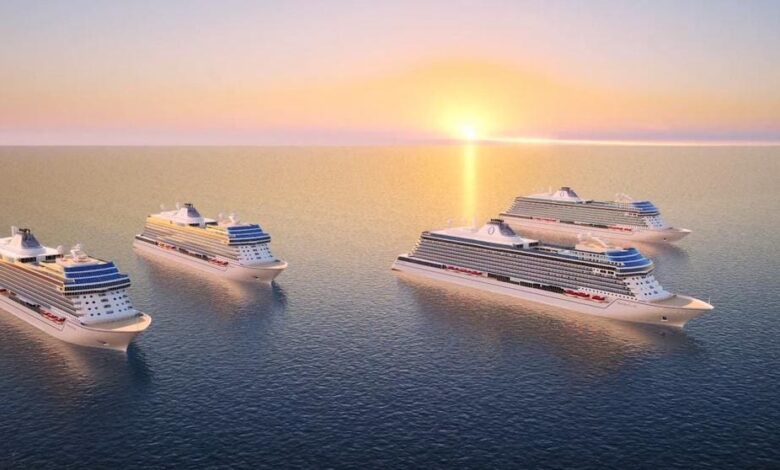10 Differences Between The New Oceania Allura And Vista Cruise Ships

📝 usncan Note: 10 Differences Between The New Oceania Allura And Vista Cruise Ships
Disclaimer: This content has been prepared based on currently trending topics to increase your awareness.
Allura is the second in the fleet of Allura class ships for Oceania Cruises.
Oceania Cruises
Oceania’s second ship in its new Allura class has set sail on its maiden voyage taking travelers on itineraries around the Mediterranean Sea. The 1,200-passenger Oceania Allura follows Oceania Vista, which launched in May 2023 and is also currently sailing in Europe. Both ships will move to the Caribbean for the winter season and return to Europe next summer.
New for Vista is a 129-day sailing, dubbed the Kangaroo Route, from Sydney to London visiting more than 80 ports in 34 countries, beginning Feb. 26, 2027.
Oceania is well-known for its focus on culinary travel and onboard dining experiences, but also for service (there is a ratio of two staff for every three guests). While this is certainly not a surprise for a cruise ship, Oceania takes it to the next level. An onboard cooking school, elevated dining in specialty restaurants (all free for guests) and specialty chef partnerships lure foodies who recognize Oceania’s sailings as a cut above other cruise lines that may focus more on shipboard amenities as their primary selling point.
The pool deck on Oceania Allura
Oceania
While the two ships are nearly identical, the cruise line made some tweaks (as all cruise companies do) when evolving their ships as they join the fleet. This takes into account customer and employee feedback, historical data on what venues and areas of the ship prove more popular than others during its first year of sailing, and the latest trends in the industry. As a result, Oceania Allura looks very similar, yet has a few notable differences for the eagle-eyed sailor. This is what you can expect.
New dining venues and menus
Aquamar Kitchen on Oceania Allura
Oceania
With an 8-to-1 chef-to-guest ratio, there is no question that the caliber and quality of food is going to be elevated. In fact, half of the ship’s crew works in restaurant and bar service.
“Oceania is definitely a line for foodies,” says Jason Leppert, editor of PopularCruising.com. “Compared to other lines, it offers more included specialty dining choices, making it a great value, especially on its newer ships like Allura.”
The newest Oceania ship certainly allures with its wide array of new food and beverage options on board that are not currently sailing (or at least yet) on older sister Oceania Vista.
A new creperie is on Allura and prepares a variety of sweet dishes, including Belgian and bubble waffles.
Oceania
A new French crêperie prepares the French pastry in both savory and sweet form, along with frozen yogurt and other treats like bubble and Belgian waffles or ice cream sundaes. This is all complimentary for guests and served in a care overlooking the pool deck and patios. Not only is this new to Allura, but also to the entire fleet as this venue is an entirely new concept for the brand.
The Privee private dining room
Oceania
The French dining room Jacques, named for and serving classic recipes from well-known chef Jacques Pépin, is also new to Allura. This specialty dining restaurant has proven popular on other ships in its fleet (like Marina and Riviera), and Vista will eventually be getting its own Jacques by late 2025. Allura also showcases a new line of service and flatware, which will eventually be the Jacques standard on other Oceania ships.
Also new to Oceania is more tableside preparation of certain dishes like hand-cut beef tartare mixed a la minute in front of guests. And in the Grand Dining Room, 270 new recipes have been added to Allura’s menu, like a new eggs benedict menu at breakfast.
Passengers can learn to cook recipes related to the itinerary’s destinations.
Oceania
Another novelty for Allura is at Red Ginger, the Asian fusion restaurant found on other Oceania ships, but here it has a new Nikkei menu, blending Japanese and Peruvian flavors. A dozen new dishes are on the menu like a braised Peruvian short rib, soft shell crab tempura bao buns and chicken anticuchos skewers in a spicy huacaina sauce.
Leppert points out that cooking classes are not new to cruise lines, citing brands like Explora Journeys, but that typically those lines have a higher price point. Oceania is the only line in its competitive set to offer such a robust culinary center experience.
The Grand Dining Room serves three meals a day.
Oceania
Many are sure to book the new Gerard Bertrand wine pairing lunch, which leans heavily into his bio-dynamic and ecological wine labels. Each course has its own special wine selection, but this once-a-cruise special event does carry an extra charge of $175 per person. This is the only dining experience that costs extra and debuted on Allura. Vista will eventually get this wine pairing lunch later this year, and two more Oceania ships (Riviera and Marina) will follow suit in 2026.
A selection of gelato and ice cream is now available by the pool in addition to Terrace Cafe, too, something not found on Vista when it launched. Terrace Café also has changes of its own, including a new Indian corner with 15 new menu items available at dinner and 45 new sushi roll recipes on offer
Toscana restaurant has its own olive oil master that offers a menu of olive oils to pair with the food.
Oceania
For those that like consistency, many of the other onboard venues remain the same, including Toscana (with its own olive oil master), Aquamar Kitchen (with made-to-order smoothies and grain bowls) and the Viennese coffee menu at Baristas (although Italian brand Illy is no longer on offer).
At the onboard cooking school ($89 per person), 24 cooking stations allow guests to learn how to make signature recipes from the destinations on the itinerary from licensed culinary faculty.
Samantha Davis-Friedman of Travel Age West says Oceania’s “uniquely food-focused cruise experience” is popular with cruisers, so much so that it has become the “highest-rated onboard experience for 14 years.”
A few onboard shuffles
The grand staircase in the cruise’s foyer.
Oceania
Common when cruise lines launch a new series of ships, there are tweaks made to the design after crew give feedback on the success of the layout. For example, the library on Allura was moved to be next to Horizons Lounge and digital center, where guests can learn tips and tricks about photography and using mobile devices. On Vista, it is next to the coffee bar; Allura’s new location allows the space to be much quieter.
Another key change made to this ship targets solo travelers. While Vista has cabins designed for singles, Oceania Allura does not (although they can still pay a supplement to book a standard cabin for just one person).
Environmental differences
A stateroom with balcony on Oceania Allura
Oceania
For some travelers, it is the eco-friendly changes that Allura brings to Oceania’s fleet that will most impress. Ship-building timelines mean that sometimes a new series of ships may not debut with the latest technology, if it is not ready in time.
Such is the case with Allura, which relies exclusively on marine gas oil (MGO) instead of heavy fuel oil (HFO), giving it a more sustainable operation. This green option was not fully ready yet when Vista was being developed.
According to Giuseppe Cusenza, project manager at the shipyard, this type of fuel “produces significantly lower sulfur oxide and particulate emissions.”
Oceania Allura is currently sailing in southern Europe.
Oceania
Other green features of Allura include onboard “food digestors” that convert food waste to liquid and a waste heat recovery system that uses excess warmth from the engines to help with the freshwater desalination process (reducing overall energy usage). The ship also features shore power systems that help to reduce emissions while a ship is in port.
There is also a trim stabilizer designed to reduce the ship’s roll sensation by up to 77% by monitoring stability levels and adjusting its balance accordingly as well as a lower friction hull coating to reduce drag and improve efficiency.
Horizons Lounge on the top deck of Allura.
Oceania
Overall, this ship is more efficient, allowing it to use less fuel and reduce overall emissions. There’s also a system that can monitor the ship’s needs and adjust energy usage in real time.
While most people choose a cruise based on the itinerary, these changes, along with the line’s culinary focus, give Allura a differentiating factor.
As Davis-Friedman calls it, Oceania is a foodie experience from “ship to shore,” and that continues with the debut of its newest ship.
MORE FROM FORBES



